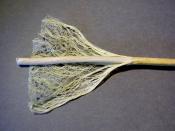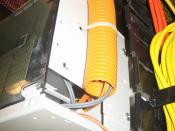1. SUMMARY
1.1 Identity, physical and chemical properties
Carbon/graphite fibres are filamentary forms of carbon produced by high-temperature processing of one of three precursor materials: rayon (regenerated cellulose), pitch (coal tar or petroleum residue) or polyacrylonitrile (PAN). Nominal diameters of carbon fibres range between 5 and 15 õm. Carbon fibres are flexible and electrically and thermally conductive, and in high performance varieties have high Young's modulus (cooefficient of elasticity measuring the softness or stiffness of the material) and tensile strength. They are corrosion resistant, lightweight, refractile and chemically inert (except to oxidation), and have a high degree of stability to traction forces, low thermal expansion and density, and high abrasion and wear resistance.
Aramid fibres are formed by the reaction of aromatic diamines and aromatic diacid chlorides. They are produced as continuous filaments, staple and pulp. There are two main types of aramid fibres, para - and meta - aramid, both with a nominal diameter of 12-15 õm.
Para-aramid fibres can have fine-curled, tangled fibrils within the respirable size range (< 1 õm in diameter) attached to the surface of the core fibre. These fibrils may be detached and become airborne upon abrasion during manufacture or use. Generally, aramid fibres exhibit medium to very high tensile strength, medium to low elongation and moderate to very high Young's modulus. They are resistant to heat, chemicals and abrasion.
Polyolefin fibres are long-chain polymers composed of at least 85 % by weight of ethylene, propylene or other olefin units; polyethylene and polypropylene are used commercially. Except for some types such as microfibre, the nominal diameters of most classes of polyolefin fibres are sufficiently large that they are within the respirable size range.
Polyolefins are extremely hydrophobic and unreactive. Their tensile strengths are considerably less than those of carbon or aramid fibres and they...


